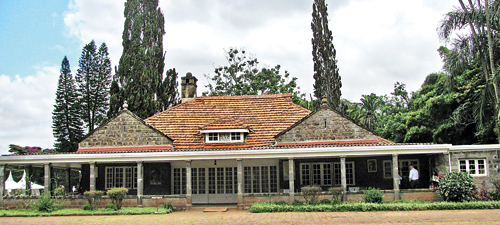In to Africa

Karen Blixen’s home, now a museum
This was going to be our first trip to East Africa.
My interest in East Africa commenced due to my hobby of stamp collecting – colourful postage stamps from the British East African Federation comprising the colonies of Kenya, Uganda and Tanganyika. It was nurtured by the stories we used to have as schoolboys of Tarzan in the Dell comics and The Phantom in the Gold Key comics– and later on by Danish author Karen Blixen’s Out of Africa– the story of her life as a coffee planter in colonial Kenya.
So when the opportunity arose to travel with a couple of friends to Kenya and Tanzania we decided to make full use of the chance to experience for ourselves the beauty of the African wild –those world famous nature reserves like Tanzania’s Serengeti and its northern extension the Masai Mara of Kenya. This would be, we hoped, a once in a lifetime opportunity of seeing the mighty jungle where the lion sleeps and the rolling savannah where the buffalo roam – along with the zebra and the giraffe and the wildebeest.
We found that the most convenient way to get to East Africa from Colombo was via Abu Dhabi and then on to Nairobi the capital of Kenya. A word of warning about Nairobi: traffic here is terrible, so set aside an appropriate amount of time for travel between the airport and the city sights. We stayed on arrival in the CBD’s Sarova Stanley Hotel –the equivalent of Colombo’s Galle Face Hotel, built at the beginning of the 20th century during British colonial times and known since then as the traditional meeting place for those going on safari in Kenya.Wooden floors, old style ceiling fans and the famous Thorn Tree café (in the centre of which grows a magnificent Acacia tree) add to the old world charm of this heritage hotel. At the end of our safari, we booked into a hotel less than half an hour’s drive from the airport- the Hilton Garden Inn Airport which was not only very affordable but also most comfortable.
Spending a couple of days after arrival in Nairobi is a wise move for two reasons. It allows you to overcome jet lag and get accustomed to the changed time zone – and it also allows you to explore this interesting city.
Nairobi started life as a rail depot on the railway that the British were building from the seaport of Mombasa to Kampala, the capital of Uganda in the interior. Gradually the city grew in size and importance. Today it is not only the capital of Kenya but also one of the largest cities in Africa.
Among the sights you should make sure to see in Nairobi is the Nairobi National Park, situated virtually on the doorstep of the city. Where other cities would have genteel suburbs at this proximity to their city centres, Nairobi has a nature reserve in which one can see zebra, rhinoceros, leopard, giraffe and even the occasional lion against the backdrop of the city skyscrapers. Established in 1946 it was Kenya’s first nature reserve – and today, about 7 kilometres south of the city centre, these animals live in their natural habitat of open grass plains separated from the metropolis by an electric fence.
Other wildlife attractions you can see here are the elephant orphanage run by the David Sheldrick Wildlife Trust (a bit like our own Pinnawala Elephant Orphanage) and, about 40 minutes from the city centre, Langata’s Giraffe Centre run by the African Centre for Endangered Wildlife.
For me a highlight of our visit to Nairobi was visiting the Karen Blixen Museum - the former home of this Danish author, built on her coffee plantation “at the foot of the Ngong Hills” where she spent most of her life before retiring to her native Denmark. Made famous by her book Out of Africa – and the 1985 movie starring Meryl Streep and Robert Redford – the house was given as an independence gift by the Danish government to the Kenyan government, who converted it into a museum to celebrate Blixen’s life and contribution to the country.
And while on the subject of museums, the Nairobi National Museum is excellent – not only for its collections of stuffed birds and animals plus exhibits from Kenya’s rich collection of tribes, but for the engaging HistoriaYa Kenya display which takes one on a historical journey through East Africa. This provides a well presented view of the nation’s history from the Kenyan perspective – quite a contrast to the history written by the colonisers which we in other British colonies like Ceylon were fed by the British.
Our two days in Nairobi were well worth the stay – much better than rushing straight from the airport on our safari to Lake Nakuru, the Masai Mara and Amboseli Nature Reserve. It gave us the chance to recover from the journey – and see the sights of what turned out to be a most interesting city.


